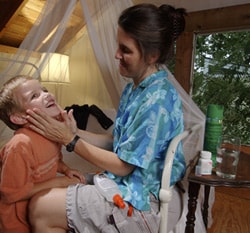Dengue Fever & Dengue Hemorrhagic Fever
INFECTIOUS AGENT
The 4 dengue viruses (DENV) are immunologically related, positive-strand RNA viruses of the genus Flavivirus, family Flaviviridae. These viruses cause both dengue fever (DF) and dengue hemorrhagic fever (DHF). Asymptomatic infection also occurs. Infection with 1 DENV produces lifelong immunity against reinfection with that DENV type but no long-term cross-protection against the other 3 DENV types (any cross-protection is ≤2 months).
MODE OF TRANSMISSION
Transmission occurs principally from the bite of an infected Aedes aegypti (and, less commonly, Ae. albopictus or Ae. polynesiensis) mosquito. Female mosquitoes acquire DENV by biting viremic humans and become infective after an extrinsic incubation period of 8–12 days. The infected mosquito can then transmit DENV for the rest of its life (the mosquito lifespan is approximately 1 month).
Less common modes of DENV transmission include through exposure to DENV-infected blood, organs, or other tissues via blood transfusion, solid organ or bone marrow transplantation, and nosocomial injury (needlestick or mucous membrane contact with spilled blood). DENV can be vertically transmitted from an infected woman to her fetus in utero or to the infant during childbirth. Direct person-to-person transmission has not been documented.
EPIDEMIOLOGY
DENV infections have been reported in over 100 countries in Africa, the Americas, the Caribbean, Eastern Mediterranean, Southeast Asia and the Western Pacific regions (Maps 3-01 and 3-02). The World Health Organization (WHO) estimates that 50 million cases of dengue occur every year, and 500,000 (1%) require hospitalization. The geographic spread of dengue is similar to that of malaria, but unlike malaria, dengue is often found in populated urban and residential areas of tropical nations.
Several dengue outbreaks have been detected in the continental United States since 1980, including 7 outbreaks in southern Texas along the United States-Mexico border, one outbreak in Hawaii in 2001, and 2 outbreaks in southern Florida in 2009 and 2010. Several southeastern states have a nearly year-round Aedes population, a susceptible human population, and ample opportunity for viral introduction from international visitors and returning US travelers. Differences in housing (use of air conditioning and screens, for example) and lifestyle, however, may prevent dengue from becoming endemic in these states.
Cases of DF and DHF are confirmed every year among travelers returning to the United States. However, it was not until June 2009 that DENV infections became nationally reportable in the United States, so case reporting among travelers before January 2010 is limited. Infection rates (based on serology) among febrile travelers returning from dengue-endemic areas in the tropics are 3%–8%. In a recent study of 17,353 ill travelers seen at GeoSentinel surveillance network clinics, dengue was the leading cause of systemic febrile illness among travelers returning from the Caribbean, South America, south-central Asia, and Southeast Asia. In some case studies, dengue is the second most common cause of hospitalization (malaria is the most common) among travelers returning from the tropics.
Published data are limited on the health outcomes associated with DENV infection among pregnant women and the effects of maternal DENV infection on a developing fetus. Vertical transmission can occur, and peripartum maternal infections may increase the likelihood of symptomatic disease in the newborn. Of the 24 vertical transmission cases described in the literature, average time of onset between maternal and neonatal onset of fever was 7 days (range, 5–13 days). All cases presented with fever and thrombocytopenia, and many also had hepatomegaly and hemorrhage. Transplacental transfer of maternal IgG anti-DENV (from a previous maternal infection) may place infants at higher risk for DHF if they acquire DENV infection during the second half of their first year of life.
Prevention
This photograph shows a mother applying mosquito repellent to her child’s skin in order to prevent mosquitos from biting.
How to reduce your risk of dengue infection:
There is no vaccine available against dengue, and there are no specific medications to treat a dengue infection. This makes prevention the most important step, and prevention means avoiding mosquito bites if you live in or travel to an endemic area.
The best way to reduce mosquitoes is to eliminate the places where the mosquito lays her eggs, like artificial containers that hold water in and around the home. Outdoors, clean water containers like pet and animal watering containers, flower planter dishes or cover water storage barrels. Look for standing water indoors such as in vases with fresh flowers and clean at least once a week.
The adult mosquitoes like to bite inside as well as around homes, during the day and at night when the lights are on. To protect yourself, use repellent on your skin while indoors or out. When possible, wear long sleeves and pants for additional protection. Also, make sure window and door screens are secure and without holes. If available, use air-conditioning.
If someone in your house is ill with dengue, take extra precautions to prevent mosquitoes from biting the patient and going on to bite others in the household. Sleep under a mosquito bed net, eliminate mosquitoes you find indoors and wear repellent!
List of repellant products approved by the EPA :
List of repellant products approved by the EPA :
Courtsey : CDC Atlanta

No comments:
Post a Comment